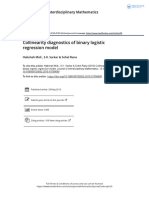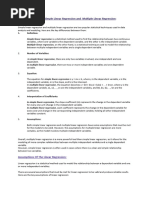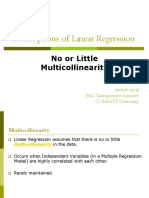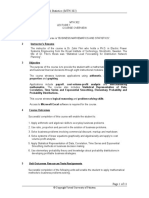Econometrics Assignment
Uploaded by
nebaneba321Econometrics Assignment
Uploaded by
nebaneba3211
HAWASSA UNIVERSITY
COLLEGE OF BUSINESS AND
ECONOMICS
DEPARTMENT OF ECONOMICS
GROUP ASSIGNMENT FOR ECONOMETRICS ONE
NAME OF STUDENTS ID.NO
1. SEBEWONEL TEADEL _____________________________________ SoScR/0413/15
2. MERON GETACHEW _____________________________________ SoScR/1981/15
3. JONAH SUNDAY _________________________________________ SoScR/1393/14
4. WOYNSHET ATINAFU _____________________________________ SoScR/2093/15
5. ASEFAW MANDFRO ______________________________________ SoScR/1188/15
6. NEBIL MOHAMMED ______________________________________ SoScR/0368/15
7. TSIYON ATALEW _________________________________________ SocSR/1440/15
8. MERSHAYE ABERA_______________________________________ SocSR/0324/15
Submitted to: - Dr, Abate yesigat
[DOCUMENT TITLE] ECONOMETRICS
2
[DOCUMENT TITLE] ECONOMETRICS
3
[DOCUMENT TITLE] ECONOMETRICS
4
[DOCUMENT TITLE] ECONOMETRICS
5
3.Discuss the nature, causes, consequences, and remedies of each of the
following problems we might encounter in regression analysis.
a) Multicollinearity
b) Heteroscedasticity
A. Multicollinearity in Regression Analysis
Multicollinearity is a phenomenon in regression analysis where two or more predictor
variables (independent variables) are highly correlated with each other. This high
correlation makes it difficult to isolate the individual effect of each predictor variable
on the dependent variable.
1. Nature of Multicollinearity
In simple terms, multicollinearity occurs when there is a strong linear relationship
between two or more independent variables in a regression model. This can create
several issues for regression analysis, particularly with interpreting coefficients and
making reliable predictions. There are two main types of multicollinearity:
• Perfect Multicollinearity: This occurs when one independent variable is an exact
linear function of another. Perfect multicollinearity is rare but can lead to an inability
to estimate the regression coefficients for the correlated variables.
• Imperfect or High Multicollinearity: This is more common and occurs when the
correlation between two or more independent variables is very high, but not exactly
1 or -1.
• 2. Causes of Multicollinearity
Several factors can contribute to the occurrence of multicollinearity:
• Inclusion of Highly Correlated Variables: Sometimes, multiple predictor variables in
a model may be closely related, even though they measure different aspects of a
concept (e.g., height in inches and height in centimeters).
• Measurement Errors: If one or more variables are measured with error, this can
increase correlations between predictors.
• Overfitting the Model: Adding too many independent variables to the regression
model, especially those that are similar or highly correlated, can increase
multicollinearity.
• Linear Relationships in Data: In some cases, multicollinearity arises naturally in the
dataset due to inherent relationships between variables, such as in economic data
(e.g., income and education level).
• Polynomial and Interaction Terms: Including interaction terms or higher-degree
polynomial terms can also cause multicollinearity if the variables involved are
already correlated.
[DOCUMENT TITLE] ECONOMETRICS
6
3. Consequences of Multicollinearity
Multicollinearity can lead to several issues in regression analysis:
Unstable Coefficients: When predictors are highly correlated, it becomes
difficult to determine the individual effect of each variable on the dependent
variable. The regression coefficients become highly sensitive to small changes
in the model or the data, making them unstable.
o For example, adding or removing a correlated variable can lead to large
changes in the estimated coefficients of other variables.
Inflated Standard Errors: Multicollinearity causes the standard errors of the
estimated coefficients to increase. This inflation reduces the precision of the
coefficient estimates and makes it more difficult to determine if the variables
are statistically significant.
Significance Testing Problems: With large standard errors, the t-statistics for
individual predictors decrease, which can lead to a failure in rejecting the null
hypothesis that a coefficient is equal to zero (i.e., failing to find significant
predictors even if they should be significant).
Redundancy in Variables: If two variables are highly correlated, they may
essentially be capturing the same information. This redundancy does not
provide additional explanatory power but makes the model unnecessarily
complex.
Misleading Conclusions: The interpretation of the coefficients may become
misleading, making it difficult to understand the relationship between each
predictor and the dependent variable. For example, you might incorrectly
attribute the effect of one variable to another highly correlated one.
4. Remedies for Multicollinearity
Several strategies can be used to address multicollinearity:
Examine Correlation Matrix: Before fitting a regression model, examine the
correlation matrix of all independent variables. If two variables are highly
correlated (typically with a correlation coefficient above 0.8), this is an
indicator of potential multicollinearity.
Remove Highly Correlated Variables: If two variables are highly correlated,
it may be worth removing one from the model. This can simplify the model
and reduce multicollinearity. Sometimes, domain knowledge can help decide
which variable to keep.
Combine Correlated Variables: In some cases, it might make sense to
combine correlated variables into a single composite variable. For example, if
[DOCUMENT TITLE] ECONOMETRICS
7
"income" and "education level" are highly correlated, they might be combined
into a socioeconomic status score.
Use Principal Component Analysis (PCA): PCA is a dimensionality
reduction technique that can transform correlated predictors into a smaller set
of uncorrelated components. These components can then be used in the
regression model instead of the original variables, helping mitigate
multicollinearity.
Apply Ridge or Lasso Regression: These are regularization techniques that
can help reduce the impact of multicollinearity:
o Ridge Regression (L2 regularization) adds a penalty proportional to the
square of the coefficients to the loss function. This helps shrink the
coefficients of correlated predictors, making them more stable.
o Lasso Regression (L1 regularization) can help by setting some coefficients to
zero, effectively removing some correlated predictors from the model.
Increase Sample Size: If multicollinearity arises from limited data, increasing
the sample size may help stabilize the estimates of the coefficients and reduce
the impact of multicollinearity.
Centering Variables: In some cases, centering the variables (subtracting the
mean from each variable) can help reduce multicollinearity, especially in the
presence of interaction terms or polynomial terms. Centering does not remove
the correlation but can reduce some computational issues.
Use Variance Inflation Factor (VIF): VIF is a diagnostic tool that quantifies
how much the variance of a regression coefficient is inflated due to
collinearity with other predictors. A high VIF (typically greater than 10)
indicates significant multicollinearity. Variables with high VIFs can be
considered for removal or transformation.
5. Diagnosing Multicollinearity
Correlation Matrix: This is the simplest way to detect multicollinearity. If
two or more predictors have a high correlation coefficient (above 0.8 or 0.9),
multicollinearity may be present.
Variance Inflation Factor (VIF): VIF measures how much the variance of a
regression coefficient is inflated because of collinearity with other variables. A
VIF value greater than 10 is typically considered indicative of problematic
multicollinearity.
Condition Index: The condition index is another diagnostic tool. It is used in
conjunction with the eigenvalues of the predictor matrix. High condition
indices (greater than 30) often signal multicollinearity.
[DOCUMENT TITLE] ECONOMETRICS
8
Tolerance: Tolerance is the reciprocal of VIF (i.e., 1/VIF1 / VIF1/VIF).
Tolerance values close to 0 indicate severe multicollinearity.
B. Heteroscedasticity in Regression Analysis
Heteroscedasticity refers to a situation in regression analysis where the variance of the
errors (or residuals) is not constant across all levels of the independent variable(s). In
simple terms, it occurs when the spread or dispersion of the residuals varies
systematically with the values of the independent variables. This violates one of the
key assumptions of classical linear regression, which assumes homoscedasticity
(constant variance of errors).
1. Nature of Heteroscedasticity
Inconsistent Variance of Errors: In a homoscedastic model, the variability
(spread) of residuals should be roughly the same across all levels of the
independent variable(s). However, in the case of heteroscedasticity, the
residuals' spread increases or decreases as the value of the predictor variable
changes.
Graphical Indicators: Heteroscedasticity can often be visually identified
through a scatter plot of residuals versus fitted values. If the variance of the
residuals changes systematically (e.g., wider spread for larger values of the
independent variable), the plot will show a "fan" or "cone" shape.
Example: In a simple linear regression model, if the residuals tend to spread
out more as the predicted values (fitted values) increase, this is an indicator of
heteroscedasticity.
2. Causes of Heteroscedasticity
Several factors can contribute to heteroscedasticity:
Non-constant Variability in the Data: In some real-world situations,
variability of the dependent variable naturally increases or decreases as the
level of the independent variable changes. For example, in income-related
models, the variance of income may increase as income levels rise (because
higher-income groups often show more variation in their earnings).
Model Misspecification: Heteroscedasticity can result from incorrect model
specification. For instance, omitting important predictor variables (which
influence the dependent variable) or using an incorrect functional form (e.g.,
linear instead of logarithmic) can lead to heteroscedastic errors.
Presence of Outliers: Outliers or extreme values in the data can sometimes
cause heteroscedasticity, as these values might cause residuals to behave
erratically, leading to a non-constant variance.
[DOCUMENT TITLE] ECONOMETRICS
9
Measurement Error: If there are errors in measuring the dependent or
independent variables, it can cause the variance of the residuals to vary across
observations.
Data Transformation: If the data is not properly transformed (for example,
failing to log-transform highly skewed data), heteroscedasticity can emerge as
the spread of errors becomes larger or smaller as the independent variable(s)
change.
3. Consequences of Heteroscedasticity
Heteroscedasticity can have several negative effects on the results of a regression
analysis:
Inefficient Estimates: Ordinary Least Squares (OLS) estimates remain
unbiased in the presence of heteroscedasticity, but they are no longer efficient.
This means that while the estimated coefficients will still be correct on
average, they will no longer have the minimum possible variance. Therefore,
they will not be the best (most precise) estimates.
Inflated Standard Errors: One of the primary consequences of
heteroscedasticity is that it leads to incorrect standard errors. These errors can
become too large or too small depending on the pattern of heteroscedasticity.
This results in inaccurate significance tests (e.g., t-tests), potentially leading to
the wrong conclusions about whether predictors are significant or not
Invalid Inference: Since the standard errors are incorrect, hypothesis tests
(e.g., testing if a coefficient is zero) may lead to false positives (Type I errors)
or false negatives (Type II errors). For example, you might incorrectly reject a
null hypothesis (finding a variable significant when it isn’t) or fail to reject a
false null hypothesis (failing to detect a significant relationship).
Ineffective Confidence Intervals: Inaccurate standard errors also lead to
incorrect confidence intervals for the estimated coefficients. These intervals
might be too wide or too narrow, giving misleading results about the precision
of the estimates.
Model Fit and Predictive Power: The presence of heteroscedasticity does not
necessarily affect the fit of the model (i.e., R-squared remains valid), but it
affects the reliability of statistical tests on the coefficients, which can
undermine the usefulness of the model for making predictions or drawing
inferences.
4. Remedies for Heteroscedasticity
There are several ways to deal with heteroscedasticity, depending on the severity of
the problem and the context of the data:
Transform the Dependent Variable: A common remedy is to apply a
transformation to the dependent variable (e.g., a log transformation, square
[DOCUMENT TITLE] ECONOMETRICS
10
root transformation, or inverse transformation). This can help stabilize the
variance of the errors. For instance, taking the natural logarithm of income
data can reduce heteroscedasticity because the variability tends to be more
uniform on a logarithmic scale.
Weighted Least Squares (WLS): WLS is a method where different
observations are given different weights based on the variance of their
residuals. Observations with larger error variance are down-weighted, while
those with smaller error variance are up-weighted. This corrects for
heteroscedasticity and ensures more efficient estimates.
Use Robust Standard Errors: A simple and popular approach is to compute
robust standard errors (also called heteroscedasticity-consistent standard
errors). These adjusted standard errors correct for the non-constant variance
and allow for valid hypothesis testing even in the presence of
heteroscedasticity. One common type of robust standard error is the Huber-
White standard error.
Generalized Least Squares (GLS): GLS is another method that attempts to
correct heteroscedasticity by modeling the structure of the variance-covariance
matrix of the errors. This approach requires an assumption about how the
variance changes, and it adjusts the estimation process accordingly to account
for it.
Examine the Functional Form: Heteroscedasticity may arise from a
misspecified functional form of the model. For example, using a linear model
when the relationship between the dependent and independent variables is
non-linear can lead to heteroscedastic errors. A non-linear model, polynomial
regression, or adding interaction terms might resolve this issue.
Add Missing Variables: If the heteroscedasticity is caused by omitted
variable bias, adding relevant variables to the model could correct the issue.
For instance, adding income as a control in a model predicting household
expenditures could reduce heteroscedasticity.
Use of Non-Parametric Methods: In some cases, non-parametric or semi-
parametric models (e.g., generalized additive models or kernel regression) can
provide more flexibility in modeling relationships and errors that exhibit
heteroscedasticity.
5. Diagnosing Heteroscedasticity
Several diagnostic tools and tests are available to detect heteroscedasticity in
regression models:
Residual Plot: Plotting the residuals (errors) versus the fitted values is one of
the most common ways to detect heteroscedasticity. A pattern where residuals
fan out or contract as the fitted values change indicates heteroscedasticity.
[DOCUMENT TITLE] ECONOMETRICS
11
Breusch-Pagan Test: This is a statistical test that detects the presence of
heteroscedasticity. The null hypothesis of the test is that the variance of the
residuals is constant (i.e., homoscedasticity). A significant result (small p-
value) suggests the presence of heteroscedasticity.
White’s Test: White’s test is another heteroscedasticity test that is more
general than the Breusch-Pagan test, as it does not assume a specific form for
the heteroscedasticity. It can detect both heteroscedasticity and model
misspecification.
Goldfeld-Quandt Test: This test is used for detecting heteroscedasticity when
there is a suspicion that the variance of the errors depends on an independent
variable or a specific part of the data.
Plotting Residuals by Grouping: If you suspect that heteroscedasticity arises
from a categorical variable, plotting residuals against different levels of the
categorical variable can help in identifying where the variance changes.
1. Use the data file wage to work on using STATA and answer the following
questions
A. Examine the data
. describe
Contains data from C:\Users\osama\Documents\wage (1).dta
obs: 39
vars: 10 18 Mar 2001 17:39
size: 1,560
storage display value
variable name type format label variable label
HRS float %9.0g Average hours worked during the
year
RATE float %9.0g Average hourly wage ($)
ERSP float %9.0g Average yearly earnings of spouse
($)
ERNO float %9.0g Average yearly earnings of other
family members ($)
NEIN float %9.0g Average yearly non-earned income
ASSET float %9.0g Average family asset holdings
(Bank account, etc.) ($)
AGE float %9.0g Average age of respondent
DEP float %9.0g Average number of dependents
RACE float %9.0g Percent of white respondents
SCHOOL float %9.0g Average highest grade of school
completed
[DOCUMENT TITLE] ECONOMETRICS
12
B. Carry out remedial measure(s) if there is any problem with data
. misstable summarize
Obs<.
Unique
Variable Obs=. Obs>. Obs<. values Min Max
ERSP 2 37 36 342 1805
ERNO 3 36 32 30 594
DEP 2 37 36 1.159 4.512
RACE 8 31 29 9.7 83.1
# Know we are replace the missing variables by impute mean
. mean(ERSP)
Mean estimation Number of obs = 37
Mean Std. Err. [95% Conf. Interval]
ERSP 1101.703 44.88189 1010.678 1192.727
. replace ERSP=1101.703 if missing(ERSP)
(2 real changes made)
. mean DEP
Mean estimation Number of obs = 37
Mean Std. Err. [95% Conf. Interval]
DEP 2.477541 .1059457 2.262673 2.692408
. replace DEP=2.477541 if missing(DEP)
(2 real changes made)
. mean ERNO
Mean estimation Number of obs = 36
Mean Std. Err. [95% Conf. Interval]
ERNO 298.2778 15.6037 266.6006 329.955
. replace ERNO=298.2778 if missing(ERNO)
(3 real changes made)
[DOCUMENT TITLE] ECONOMETRICS
13
. mean RACE
Mean estimation Number of obs = 31
Mean Std. Err. [95% Conf. Interval]
RACE 37.96129 3.38077 31.05684 44.86574
. replace RACE=37.96129 if missing(RACE)
(8 real changes made)
C,Regress HRS on RATE, ERSP, ERNO, NEIN, AGE and DEP
. regress HRS RATE ERSP ERNO NEIN AGE DEP
Source SS df MS Number of obs = 39
F(6, 32) = 17.35
Model 119154.526 6 19859.0877 Prob > F = 0.0000
Residual 36628.7046 32 1144.64702 R-squared = 0.7649
Adj R-squared = 0.7208
Total 155783.231 38 4099.5587 Root MSE = 33.833
HRS Coef. Std. Err. t P>|t| [95% Conf. Interval]
RATE 6.525294 22.33447 0.29 0.772 -38.96853 52.01912
ERSP -.0416553 .028775 -1.45 0.157 -.1002681 .0169576
ERNO -.2493987 .0982828 -2.54 0.016 -.4495942 -.0492032
NEIN .4517179 .0768562 5.88 0.000 .295167 .6082689
AGE -4.42077 2.487202 -1.78 0.085 -9.487034 .6454937
DEP 7.89696 12.96462 0.61 0.547 -18.51111 34.30503
_cons 2244.167 110.312 20.34 0.000 2019.468 2468.865
D, Conduct model specification tests using linktest and ovtest commands of STATA,
and interpret the result
. linktest
Source SS df MS Number of obs = 39
F(2, 36) = 65.17
Model 122068.155 2 61034.0777 Prob > F = 0.0000
Residual 33715.0754 36 936.529873 R-squared = 0.7836
Adj R-squared = 0.7716
Total 155783.231 38 4099.5587 Root MSE = 30.603
HRS Coef. Std. Err. t P>|t| [95% Conf. Interval]
_hat 12.70239 6.635216 1.91 0.064 -.7544527 26.15923
_hatsq -.0027452 .0015564 -1.76 0.086 -.0059017 .0004113
_cons -12462.99 7068.384 -1.76 0.086 -26798.33 1872.36
[DOCUMENT TITLE] ECONOMETRICS
14
. ovtest
Ramsey RESET test using powers of the fitted values of HRS
Ho: model has no omitted variables
F(3, 29) = 2.50
Prob > F = 0.0792
E, Perform multicollinearity test
. vif
Variable VIF 1/VIF
NEIN 3.82 0.261487
AGE 3.66 0.273137
RATE 3.45 0.289794
ERNO 2.59 0.386270
DEP 2.20 0.455492
ERSP 1.94 0.515220
Mean VIF 2.94
F, Perform hetroscedasticity test
. hettest
Breusch-Pagan / Cook-Weisberg test for heteroskedasticity
Ho: Constant variance
Variables: fitted values of HRS
chi2(1) = 5.25
Prob > chi2 = 0.0220
G, Comment on the explanatory power and adequacy of the model
The regression model demonstrates strong explanatory power, with
an R-squared of 0.7649, indicating that approximately 76.49% of
the variation in the dependent variable (HRS) is explained by the
independent variables, and an adjusted R-squared of 0.7208,
accounting for potential overfitting. The model is statistically
significant overall, as shown by the F-statistic (17.35) and its p-
value (0.0000). However, while ERNO is statistically significant (p-
value = 0.016), the other predictors (RATE, ERSP, NEIN, AGE,
and DEP) are not, as their p-values exceed 0.05. The Root Mean
Square Error (33.833) reflects the average prediction error, but its
adequacy depends on the scale of HRS. While the model performs
well overall, improvements could be made by addressing
insignificant variables and conducting further diagnostics to
enhance its predictive accuracy.
[DOCUMENT TITLE] ECONOMETRICS
15
H,Interpret the regression coefficient
Among the significant variables:
1. ERNO (-0.2494): A one-unit increase in ERNO is associated with a decrease of 0.2494
units in HRS, holding all other variables constant. This negative relationship is statistically
significant (p-value = 0.016), suggesting that ERNO has a meaningful impact in reducing
HRS.
2. NEIN (0.4512): A one-unit increase in NEIN is associated with an increase of 0.4512
units in HRS, holding all other variables constant. This positive relationship is statistically
significant (p-value = 0.026), indicating that NEIN contributes significantly to increasing
HRS.
These findings suggest that ERNO and NEIN are key predictors of HRS, with ERNO
decreasing and NEIN increasing its valu
[DOCUMENT TITLE] ECONOMETRICS
16
5,Use the data file EARNINGS and, using STATA for analysis, carry out the
following tasks.
a. Perform a regression of EARNINGS on S where EARNINGS represent
Current hourly earnings in $ and S represents education (highest grade
completed) in number of years of schooling of the respondent. Interpret the
regression results
. regress EARNINGS S
Source SS df MS Number of obs = 540
F(1, 538) = 112.15
Model 19321.5589 1 19321.5589 Prob > F = 0.0000
Residual 92688.6722 538 172.283777 R-squared = 0.1725
Adj R-squared = 0.1710
Total 112010.231 539 207.811189 Root MSE = 13.126
EARNINGS Coef. Std. Err. t P>|t| [95% Conf. Interval]
S 2.455321 .2318512 10.59 0.000 1.999876 2.910765
_cons -13.93347 3.219851 -4.33 0.000 -20.25849 -7.608444
Earnings = -12.922 + 2.45(Saving): The intercept (-12.922) means that when saving is zero,
earnings are expected to be -12.922, indicating borrowing. The slope (2.45) shows that for
each unit increase in saving, earnings increase by 2.45 units on average.
B, Comment on the value of R2
R² = 0.1725 indicates that 17.25% of the total variation in earnings is explained by savings.
The remaining 82.75% of the variation is due to factors not included in the model or
explained by the error term.
C, Perform a test on the coefficients of regression. Explain the implications of the
result of the test. Calculate a 95% confidence interval for the slope coefficient
To test the significance of regression coefficients, we use methods like the standard error
test, t-test, or confidence intervals.
t-Test: Compare the t-calculated (10.59) to the t-critical (2.05). Since , reject , indicating the
slope coefficient is statistically significant.
Confidence Interval: At 95% confidence, the slope coefficient lies within [1.999, 2.91].
Thus, both the intercept and slope coefficients are statistically significant.
[DOCUMENT TITLE] ECONOMETRICS
17
D, Perform an F test for the goodness of fit and comment on the result
The F-test evaluates the overall significance of the model. The null hypothesis states that all
coefficients are equal to zero (). Since the F-statistic (112.15) is greater than the F-critical
value (4) and the p-value (0.000) is less than 0.05, we reject the null hypothesis. This
indicates that the coefficients are jointly significant, and the model is valid.
E, Regress S on ASVAC and SM where ASVAC is a composite measure of
numerical and verbal ability of the respondent and SM is the years of schooling of
the respondent’s mother. Repeat the regression using SF, the years of schooling of
the father, instead of SM, and again including both as regressors. Do your
regression result support the view that if you educate a male, you educate an
individual, while if you educate a female, you educate a nation?
. regress S ASVABC SM
Source SS df MS Number of obs = 540
F(2, 537) = 147.36
Model 1135.67473 2 567.837363 Prob > F = 0.0000
Residual 2069.30861 537 3.85346109 R-squared = 0.3543
Adj R-squared = 0.3519
Total 3204.98333 539 5.94616574 Root MSE = 1.963
S Coef. Std. Err. t P>|t| [95% Conf. Interval]
ASVABC .1328069 .0097389 13.64 0.000 .1136758 .151938
SM .1235071 .0330837 3.73 0.000 .0585178 .1884963
_cons 5.420733 .4930224 10.99 0.000 4.452244 6.389222
. regress S ASVABC SF
Source SS df MS Number of obs = 540
F(2, 537) = 155.49
Model 1175.37867 2 587.689333 Prob > F = 0.0000
Residual 2029.60467 537 3.77952452 R-squared = 0.3667
Adj R-squared = 0.3644
Total 3204.98333 539 5.94616574 Root MSE = 1.9441
S Coef. Std. Err. t P>|t| [95% Conf. Interval]
ASVABC .1285797 .0095914 13.41 0.000 .1097385 .1474209
SF .1289751 .0259437 4.97 0.000 .0780115 .1799387
_cons 5.541335 .4692887 11.81 0.000 4.619468 6.463202
[DOCUMENT TITLE] ECONOMETRICS
18
. regress S ASVABC SM SF
Source SS df MS Number of obs = 540
F(3, 536) = 104.30
Model 1181.36981 3 393.789935 Prob > F = 0.0000
Residual 2023.61353 536 3.77539837 R-squared = 0.3686
Adj R-squared = 0.3651
Total 3204.98333 539 5.94616574 Root MSE = 1.943
S Coef. Std. Err. t P>|t| [95% Conf. Interval]
ASVABC .1257087 .0098533 12.76 0.000 .1063528 .1450646
SM .0492424 .0390901 1.26 0.208 -.027546 .1260309
SF .1076825 .0309522 3.48 0.001 .04688 .1684851
_cons 5.370631 .4882155 11.00 0.000 4.41158 6.329681
1. For Mother's Education (SM):
The regression results show that the coefficient for SM (mother’s education) is statistically
insignificant, meaning that a mother's education does not have a significant impact on the
outcome (S). As a result, we reject the view that "if you educate a female, you educate a
nation." This implies that the mother’s education does not play a large role in shaping the
individual’s outcome in this case.
2. For Father’s Education (SF):
We conduct a hypothesis test for the father’s education, where:Null Hypothesis (Ho): "If you
educate a male, you don’t educate an individual."Alternative Hypothesis (H1): "If you
educate a male, you educate an individual."The p-value for SF is 0.001, which is less than the
0.05 significance level. This means we reject the null hypothesis and accept the alternative
hypothesis, indicating that educating a male has a significant positive impact on the
individual’s outcome.
In conclusion, the results support the idea that father's education plays a more significant
role in shaping an individual's outcome, and the impact of mother's education appears to be
less significant in this context. Thus, the hypothesis "if you educate a male, you educate an
individual" holds, but the idea "if you educate a female, you educate a nation" does not.
[DOCUMENT TITLE] ECONOMETRICS
19
F, Regress EARNINGS on S and EXP (total out-of-school work experience in years),
interpret the results and perform t test
. regress EARNINGS S EXP
Source SS df MS Number of obs = 540
F(2, 537) = 67.54
Model 22513.6473 2 11256.8237 Prob > F = 0.0000
Residual 89496.5838 537 166.660305 R-squared = 0.2010
Adj R-squared = 0.1980
Total 112010.231 539 207.811189 Root MSE = 12.91
EARNINGS Coef. Std. Err. t P>|t| [95% Conf. Interval]
S 2.678125 .2336497 11.46 0.000 2.219146 3.137105
EXP .5624326 .1285136 4.38 0.000 .3099816 .8148837
_cons -26.48501 4.27251 -6.20 0.000 -34.87789 -18.09213
the analysis involves testing the significance of the intercept (β0) and two slope coefficients
(β1 and β2) using t-tests:
1. Intercept (β0):
Null hypothesis (H₀): β0 = 0
Alternative hypothesis (H₁): β0 ≠ 0
t* = 6.20, which is greater than the critical t-value (tc) of 1.96, so we reject H₀ and conclude
that β0 is statistically significant.
Interpretation: The intercept suggests that when all explanatory variables are zero, earnings
are expected to be -26.48.
2. Slope for S (β1):
Null hypothesis (H₀): β1 = 0
Alternative hypothesis (H₁): β1 ≠ 0
t* = 11.46, which is greater than the critical t-value (tc) of 1.96, so we reject H₀ and conclude
that β1 is statistically significant.
Interpretation: For every unit increase in S, earnings (Y) increase by 2.678 units on average,
holding other factors constant.
[DOCUMENT TITLE] ECONOMETRICS
20
3. Slope for DEP (β2):
Null hypothesis (H₀): β2 = 0
Alternative hypothesis (H₁): β2 ≠ 0
t* = 4.38, which is greater than the critical t-value (tc) of 1.96, so we reject H₀ and conclude
that β2 is statistically significant.
Interpretation: For every unit increase in DEP, earnings (Y) increase by 0.562 units on
average, holding other factors constant.All coefficients are statistically significant, indicating
that the explanatory variables (S and DEP) have meaningful relationships with earnings (Y).
[DOCUMENT TITLE] ECONOMETRICS
You might also like
- IASSC Lean Six Sigma Green Belt Exam Questions - 144qNo ratings yetIASSC Lean Six Sigma Green Belt Exam Questions - 144q65 pages
- Multivariate Analysis – The Simplest Guide in the Universe: Bite-Size Stats, #6From EverandMultivariate Analysis – The Simplest Guide in the Universe: Bite-Size Stats, #6No ratings yet
- chapter 10 multicollinearity what happens if the regressors are correlatedNo ratings yetchapter 10 multicollinearity what happens if the regressors are correlated23 pages
- Linear Relationship: ANS 1. Multiple Linear Regression (MLR), Also Known Simply As Multiple Regression, Is ANo ratings yetLinear Relationship: ANS 1. Multiple Linear Regression (MLR), Also Known Simply As Multiple Regression, Is A3 pages
- Multicollinearity Occurs When The Multiple Linear Regression Analysis Includes Several Variables That Are Significantly Correlated Not Only With The Dependent Variable But Also To Each OtherNo ratings yetMulticollinearity Occurs When The Multiple Linear Regression Analysis Includes Several Variables That Are Significantly Correlated Not Only With The Dependent Variable But Also To Each Other11 pages
- A. Collinearity Diagnostics of Binary Logistic Regression ModelNo ratings yetA. Collinearity Diagnostics of Binary Logistic Regression Model16 pages
- Multicollinearity: What Happens If Explanatory Variables Are Correlated.No ratings yetMulticollinearity: What Happens If Explanatory Variables Are Correlated.20 pages
- Multicollinearity Definition, Causes and Detection Using VIFNo ratings yetMulticollinearity Definition, Causes and Detection Using VIF1 page
- Module 5: Multiple Regression Analysis: Tom IlventoNo ratings yetModule 5: Multiple Regression Analysis: Tom Ilvento20 pages
- Assumptions of Linear Regression: No or Little MulticollinearityNo ratings yetAssumptions of Linear Regression: No or Little Multicollinearity14 pages
- Chapter Four Violations of The Assumptions of Classical ModelNo ratings yetChapter Four Violations of The Assumptions of Classical Model151 pages
- Multicollinearity and Regression AnalysisNo ratings yetMulticollinearity and Regression Analysis12 pages
- Violation of Assumptions of CLR Model:: MulticollinearityNo ratings yetViolation of Assumptions of CLR Model:: Multicollinearity28 pages
- Chapter 4 Violations of The Assumptions of Classical Linear Regression Models100% (10)Chapter 4 Violations of The Assumptions of Classical Linear Regression Models10 pages
- Statistical Modelling: Regression: MulticollinearityNo ratings yetStatistical Modelling: Regression: Multicollinearity22 pages
- Two-Sample Tests of Hypothesis: Mcgraw Hill/IrwinNo ratings yetTwo-Sample Tests of Hypothesis: Mcgraw Hill/Irwin14 pages
- 1911-The Manuscript (Full Article Text) - 5278-1!10!20200906No ratings yet1911-The Manuscript (Full Article Text) - 5278-1!10!2020090612 pages
- Tugas 1 - MANPRO - Riska Tiana - 140610210002 - Silma Minnatika - 140610210014No ratings yetTugas 1 - MANPRO - Riska Tiana - 140610210002 - Silma Minnatika - 14061021001424 pages
- Point and Interval Estimation: Population Variance Is KnownNo ratings yetPoint and Interval Estimation: Population Variance Is Known2 pages
- Fast Cross-Validation Via Sequential Analysis - PaperNo ratings yetFast Cross-Validation Via Sequential Analysis - Paper5 pages
- Section - Iv Advanced Statistics - Test QuestionsNo ratings yetSection - Iv Advanced Statistics - Test Questions11 pages
- 2021 - Nature - Bayesian Statistics and Modelling100% (1)2021 - Nature - Bayesian Statistics and Modelling26 pages
- Pengaruh Human Relation (Hubungan Antar Manusia), Lingkungan Kerja Terhadap Etos Kerja Karyawan (Studi Kasus Pada PT - Pelindo Teluk Bayur Padang)No ratings yetPengaruh Human Relation (Hubungan Antar Manusia), Lingkungan Kerja Terhadap Etos Kerja Karyawan (Studi Kasus Pada PT - Pelindo Teluk Bayur Padang)14 pages
- Business Mathematics & Statistics (MTH 302)No ratings yetBusiness Mathematics & Statistics (MTH 302)11 pages
- Legendre Coefficient of Concordance 2010No ratings yetLegendre Coefficient of Concordance 20107 pages
- Aviation Forecasting Techniques - Sem 3 - MBA AviationNo ratings yetAviation Forecasting Techniques - Sem 3 - MBA Aviation109 pages
- Quantitative Skills for Animal Sciences-day 2No ratings yetQuantitative Skills for Animal Sciences-day 269 pages
- IASSC Lean Six Sigma Green Belt Exam Questions - 144qIASSC Lean Six Sigma Green Belt Exam Questions - 144q
- Multivariate Analysis – The Simplest Guide in the Universe: Bite-Size Stats, #6From EverandMultivariate Analysis – The Simplest Guide in the Universe: Bite-Size Stats, #6
- chapter 10 multicollinearity what happens if the regressors are correlatedchapter 10 multicollinearity what happens if the regressors are correlated
- Linear Relationship: ANS 1. Multiple Linear Regression (MLR), Also Known Simply As Multiple Regression, Is ALinear Relationship: ANS 1. Multiple Linear Regression (MLR), Also Known Simply As Multiple Regression, Is A
- Multicollinearity Occurs When The Multiple Linear Regression Analysis Includes Several Variables That Are Significantly Correlated Not Only With The Dependent Variable But Also To Each OtherMulticollinearity Occurs When The Multiple Linear Regression Analysis Includes Several Variables That Are Significantly Correlated Not Only With The Dependent Variable But Also To Each Other
- A. Collinearity Diagnostics of Binary Logistic Regression ModelA. Collinearity Diagnostics of Binary Logistic Regression Model
- Multicollinearity: What Happens If Explanatory Variables Are Correlated.Multicollinearity: What Happens If Explanatory Variables Are Correlated.
- Multicollinearity Definition, Causes and Detection Using VIFMulticollinearity Definition, Causes and Detection Using VIF
- Module 5: Multiple Regression Analysis: Tom IlventoModule 5: Multiple Regression Analysis: Tom Ilvento
- Assumptions of Linear Regression: No or Little MulticollinearityAssumptions of Linear Regression: No or Little Multicollinearity
- Chapter Four Violations of The Assumptions of Classical ModelChapter Four Violations of The Assumptions of Classical Model
- Violation of Assumptions of CLR Model:: MulticollinearityViolation of Assumptions of CLR Model:: Multicollinearity
- Chapter 4 Violations of The Assumptions of Classical Linear Regression ModelsChapter 4 Violations of The Assumptions of Classical Linear Regression Models
- Statistical Modelling: Regression: MulticollinearityStatistical Modelling: Regression: Multicollinearity
- Gale Researcher Guide for: Econometric ModelsFrom EverandGale Researcher Guide for: Econometric Models
- 1911-The Manuscript (Full Article Text) - 5278-1!10!202009061911-The Manuscript (Full Article Text) - 5278-1!10!20200906
- Tugas 1 - MANPRO - Riska Tiana - 140610210002 - Silma Minnatika - 140610210014Tugas 1 - MANPRO - Riska Tiana - 140610210002 - Silma Minnatika - 140610210014
- Point and Interval Estimation: Population Variance Is KnownPoint and Interval Estimation: Population Variance Is Known
- Fast Cross-Validation Via Sequential Analysis - PaperFast Cross-Validation Via Sequential Analysis - Paper
- Pengaruh Human Relation (Hubungan Antar Manusia), Lingkungan Kerja Terhadap Etos Kerja Karyawan (Studi Kasus Pada PT - Pelindo Teluk Bayur Padang)Pengaruh Human Relation (Hubungan Antar Manusia), Lingkungan Kerja Terhadap Etos Kerja Karyawan (Studi Kasus Pada PT - Pelindo Teluk Bayur Padang)
- Aviation Forecasting Techniques - Sem 3 - MBA AviationAviation Forecasting Techniques - Sem 3 - MBA Aviation

























































































